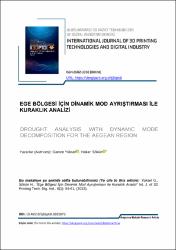EGE BÖLGESİ İÇİN DİNAMİK MOD AYRIŞTIRMASI İLE KURAKLIK ANALİZİ
Citation
Yüksel G., Sökün H., “Ege Bölgesi İçin Dinamik Mod Ayrıştırması ile Kuraklık Analizi” Int. J. of 3D Printing Tech. Dig. Ind., 6(1): 54-61, (2022).Abstract
Küresel ısınma ve diğer insani faktörlerle dünya coğrafyasını tehdit eden en önemli afetlerden biri de kuraklıktır. Kuraklık, suda yaşayan canlılardan başlayarak tüm dünya üzerindeki canlı ekosistemini doğrudan/dolaylı olarak etkilemektedir. Ülkemizde en sık görülen doğal afetlerden biri olan kuraklığın en temel özelliği, zamanla ortaya çıkması ve büyük insan kitlelerini etkilemesidir. Kuraklığın zamana bağlı olarak ortaya çıkması, kuraklığı önceden tahmin edebilme imkanını doğurmaktadır. Kuraklık probleminin tanımlanabilmesi için kuraklık indeksleri kullanılmaktadır. Yağış, sıcaklık, nem gibi meteorolojik parametreleri kullanan bu indeksler ile kuraklık sınıflandırılabilmektedir. Bu çalışmada, Ege Bölgesi için son 13 yıla ait Standart Yağış İndeksi (SPI) verisi incelenmiş ve Dinamik Mod Ayrıştırması (DMA) yöntemi kullanılarak ileriye dönük kuraklık tahminlemesi yapılmıştır. DMA, temelinde Tekil Değer Ayrıştırması olan zamana ve konuma bağlı değişen zaman serileri üzerinde çalıştırılabilen bir makine öğrenmesi metodudur. Makale kapsamında üzerinde çalışılan veri seti, World Weather Online iklim veri portalından elde edilmiştir. Veri seti bir takım ön işlemeden geçirilerek DMA algoritması ile analiz edilmiştir. DMA yönteminin Ege Bölgesi için kuraklık tahminleme başarımı, gerçek değerlerle karşılaştırılmalı olarak sunulmuştur. One of the most important disasters threatening world geography with Global Warming and other human factors is drought. Drought directly/indirectly affects the living ecosystem all over the world, starting from aquatic organisms. The most basic feature of drought, which is one of the most common natural disasters in our country, is that it occurs over time and affects large masses of people. The emergence of drought depending on time creates the possibility of predicting drought. Drought indices are used to define the drought problem. Drought can be classified with these indices, which use meteorological parameters such as precipitation, temperature, and humidity. In this study, the Standard Precipitation Index (SPI) data of the last 13 years in the Aegean Region was examined and forward-looking estimation was made using the Dynamic Mode Decomposition (DMD) method. DMD is a machine learning method that is based on Singular Value Decomposition and can be run on time series that vary depending on time and location. The data set studied was obtained from the World Weather Online climate data portal. The data set has been preprocessed and analyzed with the DMD algorithm. The estimation performance of the DMD method for drought analysis of the Aegean Region is presented in comparison with the real values.


















